If you’re in the market for a compact SUV, be prepared to be spoilt for choice, because as many as seven carmakers have a model for you. But bear with us till we bring the entire pack together for one of our giant comparisons. Today, it’s all eyes on the Korean cousins to answer the burning question, “Kia Sonet or Hyundai Venue?”
At their very core, the Sonet and Venue are one and the same. They’re both built on the same platform and share their mechanicals too but, credit to Kia and Hyundai, there’s still enough differentiation outside and inside to see these models as two unrelated compact SUVs. And as you’ll learn, there are differences in how they drive too.
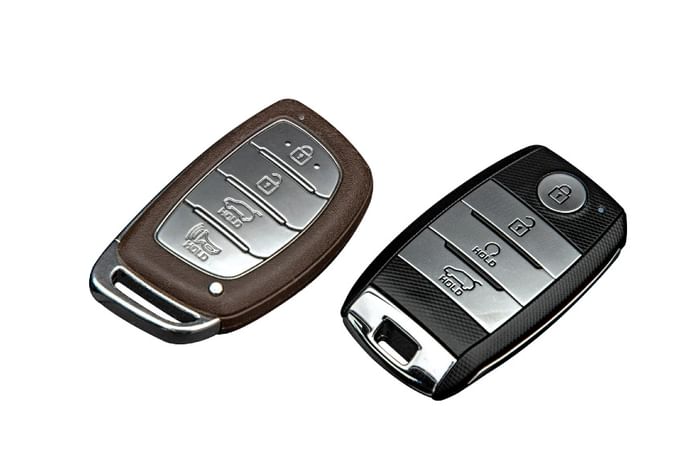
While you can get lost in the matrix of the engine, gearbox and trim options both models can be had with, to keep things even, we’ve considered the duo in their popular (and high-tech) 1.0-litre turbo-petrol engine and segment-unique dual-clutch transmission combo.
So, which of the Korean SUVs should it be?
| Dimensions | ||
|---|---|---|
| Kia Sonet GTX+ | Hyundai Venue SX+ | |
| Length | 3995mm | 3995mm |
| Width | 1790mm | 1770mm |
| Height | 1642mm | 1605mm |
| Wheelbase | 2500mm | 2500mm |
| Tyre size | 215/60 R16 | 215/60 R16 |
Beauty contest
 Sonet’s dials in line with the times.
Sonet’s dials in line with the times.Looks are a subjective matter, but when the appearance alone can tilt the balance in favour of either fraternal twin, the topic warrants being discussed at length.
Before we delve any further, though, one thing must be said. Neither model will appeal to buyers who like their SUVs simple in look. Both Korean models are big on show value. It’s the Sonet with the more traditional ‘grille flanked by headlights’ arrangement, but the face isn’t one that’ll be lost in a crowd. The big ‘tiger nose’ grille (it gets a knurled chrome surround) and large headlights with those LED DRLs, styled to look like a pulse reading, ensure as much. An upswept C pillar, a black applique that lends the rear windshield a wraparound look, and ‘heartbeat LEDs’ on the tail-lamps are other standout bits that help instantly identify this as a Sonet.
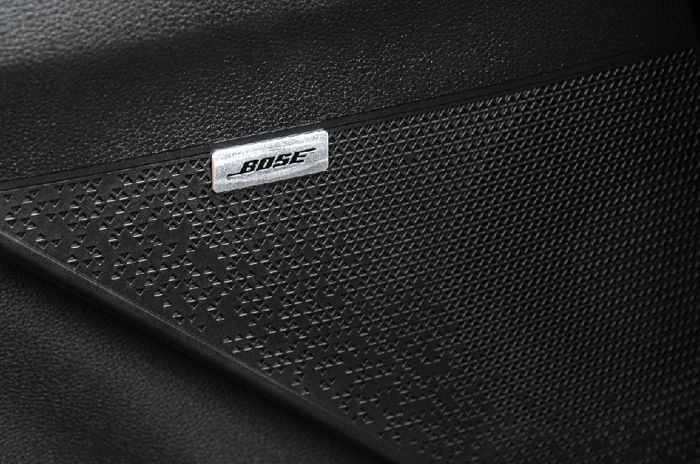
Hyundai’s trademark cascading grille and that rad split headlamp layout, (slit-like light on top and DRL-encircled main headlight cluster lower down) mean you won’t confuse a Venue for anything else either, at least from the front. You can spice up your Venue’s appearance further by opting for the new Sport pack that brings in a gloss black grille with a red insert, red accents on the wheel arches, doors and roof rails and also red front brake calipers, a treatment similar to the Sonet’s GT Line. In profile, though, the Venue is quite conventional and while the rear styling is neat, it’s also a bit anonymous. More pertinently, the Venue looks more raised hatchback than SUV from some angles.
See the duo in the same frame, and you’ll think of the Sonet as a larger vehicle, even though the models are actually near identical in size. The Kia’s sculpted bonnet and shapely wheel arches give it greater visual mass and, in general, it’s the Sonet that appears fuller and more wholesome, and importantly, looks more SUV like.
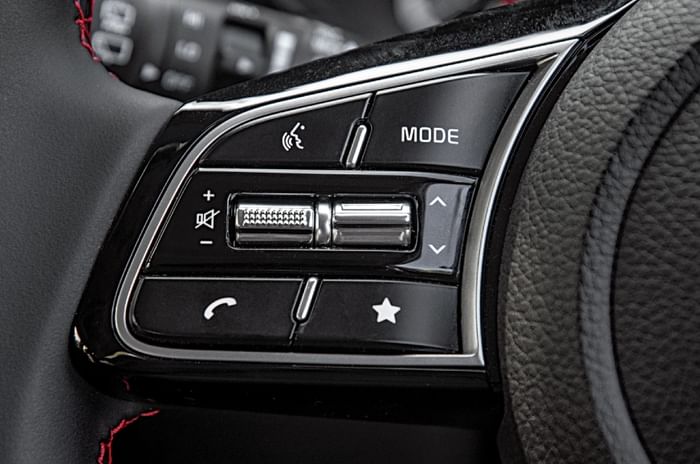
That feeling inside
Make what you want of the way they look, but the Sonet does make a better first impression when it’s time to go inside. For starters, the key fob looks like it belongs to a more expensive car, and once you open the door, you’ll think you’re entering a Seltos. There are common components, including that class-leading 10.25-inch touchscreen, but the big takeaway is that quality levels are on par with the larger and pricier Kia SUV. The knurled buttons on the steering, the textured surrounds for the gear lever and air-con vents, and even the vents themselves look and feel properly premium. Leatherette upholstery with red stitching is part of the package on the range-topping GTX+ too and does its bit to uplift the cabin ambience further. And while purists will miss conventional dials, the Sonet’s part-digital instrument cluster impresses for its clarity. Still, not everyone will find themselves at immediate ease in the Sonet. The high-set touchscreen its housing that flows into the instrument cluster, could impede visibility for shorter drivers.
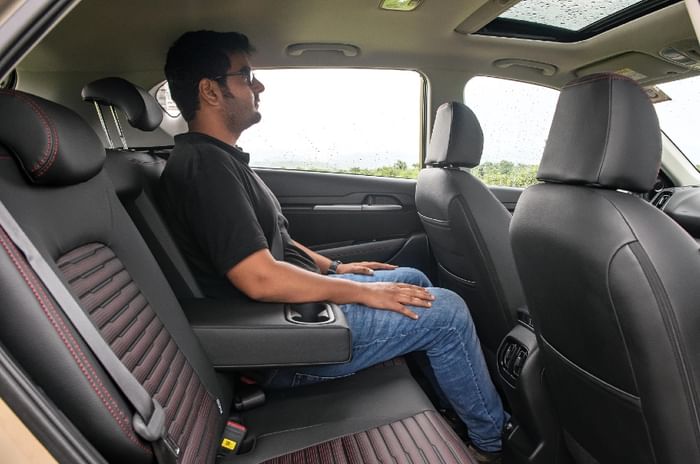
The Venue’s cabin is that crucial bit more user friendly in that sense. The Hyundai’s 8.0-inch touchscreen is lower set (but still in clear sight) while the slightly more upright B pillar also helps give a wider field of vision from the comfy driver’s perch. Then there are also elements like the chunky knobs for the air-con system and volume control that are more intuitive to use than the button-oriented setup the Kia sports. And, if you are one who stows lots of odds and ends in your car, you’ll like the shelf atop the Venue’s glovebox. Of the other things, the textured dash top is pleasing and drafting in the Creta’s steering has also helped upgrade the Venue’s cabin. Again, opt for the Sport pack if you want tasteful dashes of red inside your Venue. The thing is, while the Venue’s cabin quality impresses by established class standards, it’s a notch or two down on what you get in a Sonet.
Gadget setter
Hyundai and, more recently, Kia have set the bar when it comes to features and equipment, and that holds true even of their offerings in the compact SUV segment. However, if we talk solely of the dual-clutch transmission versions of the Sonet and Venue, it’s an unequal fight. You see, where the Sonet is available in range-topping GTX+ trim, Hyundai does not offer the Venue DCT in fully-loaded SX(O) form.

The Sonet GTX+ featured here is a substantial Rs 1.4 lakh pricier than the Venue SX+ but the Kia does make a strong case for spending big.
Over and above the dual airbags, ABS, ESC, ISOFIX child seat mounts, hill start assist, auto headlamps, tyre pressure monitor and rear parking sensors the Venue SX+ comes with, the Sonet GTX+ packs in side and curtain airbags, front parking sensors, a rear wiper and an auto-dimming rear-view mirror. The Sonet GTX+ is also the only one with LED headlamps, drive and traction modes, leatherette upholstery, ventilated front seats and a rear centre armrest. Keen drivers will, however, like the recent inclusion of paddle shifters on the Venue.
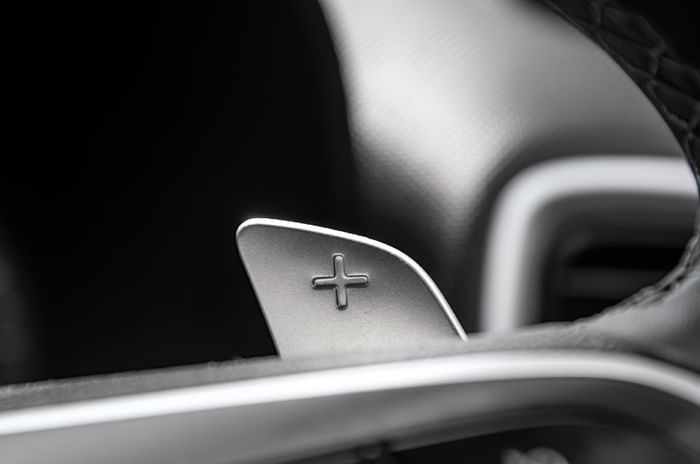
In terms of infotainment features, both models offer e-SIM-based connected tech that lets you remotely keep an eye on your vehicle, set usage parameters, start and pre-cool your vehicle and a whole lot more. The Kia does extend some connected features to your smartphone too, for times when you want to play Bond. In the all-important battle of the touchscreens, the Venue’s 8.0-inch unit is easy to navigate but it’s the Sonet’s 10.25-inch unit that’s on a whole other plane when talking slickness and resolution. Also, you won’t need to be an audiophile to declare the Sonet’s, 7-speaker Bose sound system the better one here. The Kia’s sound mood lights (LEDs that change colour with the music) are a zany but likeable inclusion too.
| Equipment | ||
|---|---|---|
| Kia Sonet GTX+ | Hyundai Venue SX+ | |
| Airbags | 6 | 2 |
| ESC | Available | Available |
| LED headlights | Available | NA |
| Leatherette upholstery | Available | NA |
| Touchscreen | 10.25-inch | 8-inch |
| Connected tech | Available | Available |
| Wireless phone charging | Available | Available |
| Sunroof | Available | Available |
| Ventilated seats | Available | NA |
| Rear AC vents | Available | Available |
| Rear wiper | Available | NA |
| Parking sensors | Front and rear | Rear |
| Paddle shifters | NA | Available |
| Drive modes | Available | NA |
Practical exam
If you will be traveling five-up in your compact SUV often, the Sonet and Venue are not the ones for you. Most rivals offer more by way of leg and shoulder room. With that out of the way, the Sonet and Venue offer reasonable space for two adults to sit in comfort at the back. Kneeroom is adequate and headroom isn’t an issue on either SUV. There are differences, however. The Venue’s longer seat squab equals more comfort on long journeys while the Sonet’s centre armrest allows for a more relaxed seating position.
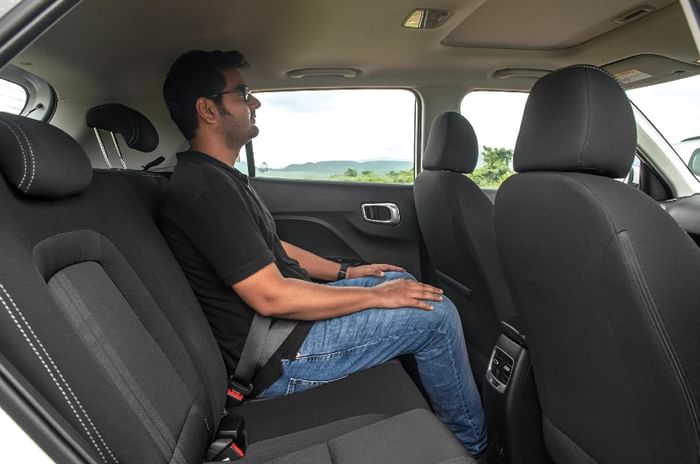
The Sonet has bragging rights in terms of luggage space, with a capacity of 392 litres to the Venue’s 350 litres. However, the difference is merely on paper, as you’ll be able to fit just as much luggage in the Venue. The rear seats can be folded down, should you want more space but what’s missing is the flexibility of a 60:40 split.
Same but different
The Kia Sonet and Hyundai Venue are powered by the same 120hp, 172Nm, 1.0-litre, three-cylinder, direct-injection, turbo-petrol engine and use the same 7-speed dual-clutch transmission to channel power to the front wheels. Expectedly, the two compact SUVs offer a similar driving experience.
In town, you’ll find an easy-going companion in both models. The engine is quiet, part-throttle responses are pleasant and the gearbox always stays well in tune with throttle inputs, even if shifts at low-speeds aren’t absolutely smooth. Driving both models back to back, did reveal the Sonet to have a slightly gentler build of power, down to its different calibration. Furthermore, the Sonet’s drive modes (Eco, Normal and Sport) that alter engine mapping, bring in some amount of adjustability to the experience too.
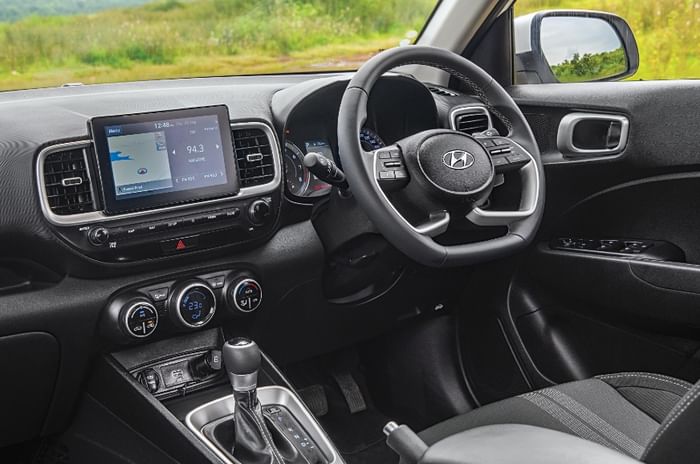
Pick up the pace and you’ll like how both SUVs perform. The gearbox cleverly keeps the engine on the boil when it senses you are driving with verve. There’s also the option to quickly go up and down the gears manually via the shift lever or, in the Venue’s case, finely crafted paddle shifters too, that bring in that added dose of engagement. There is a nice spread of power in the mid-range and there’s some fun to be had extending the engines too. But the title of faster SUV goes to the Venue, which is quicker to 100kph and also in kickdown acceleration, if only just.
| Specification and Performance | ||
|---|---|---|
| Kia Sonet GTX+ | Hyundai Venue SX+ | |
| Engine | 3 cyls, 998cc, turbo-petrol | 3 cyls, 998cc, turbo-petrol |
| Power | 120hp at 6000rpm | 120hp at 6000rpm |
| Torque | 172Nm at 1500-4000rpm | 172Nm at 1500-4000rpm |
| Gearbox | 7-speed dual-clutch auto | 7-speed dual-clutch auto |
| Fuel economy (ARAI) | 18.3kpl | 18.0kpl |
| Performance | ||
| 0-20kph | 1.70sec | 1.38sec |
| 0-40kph | 3.57sec | 3.03sec |
| 0-60kph | 5.87sec | 5.30sec |
| 0-80kph | 8.63sec | 8.14sec |
| 0-100kph | 12.25sec | 11.54sec |
| 0-120kph | 17.41sec | 16.83sec |
| 0-140kph | 24.33sec | 24.47sec |
| 0-160kph | 38.23sec | 41.54sec |
| Acceleration in gear | ||
| 20-80kph (in kickdown) | 7.43sec | 6.58sec |
| 40-100kph (in kickdown) | 9.20sec | 8.79sec |
| Noise level (dB) | ||
| Idle | 37.8dB | 39dB |
| 50kph | 62dB | 62.9dB |
| 80kph | 70.5dB | 70.5dB |
In other areas too, the differences are small but discernable. The Sonet has marginally more weight to its steering and slightly better damped suspension movements which translate to a greater feeling of confidence at high speeds. The Venue, on the other hand, is more urban in its setup, with a feather-light steering and better low-speed bump absorption. Off-road traction modes are unique to the Sonet but seem like overkill for what is a front-wheel-drive compact SUV. It’s best not to get too ambitious in the rough, in either model.
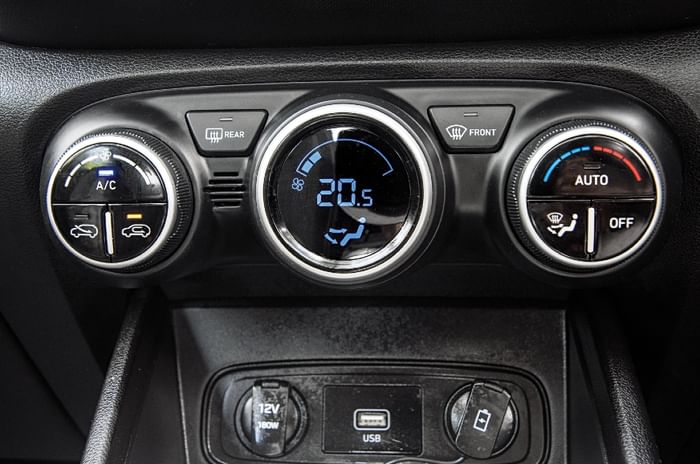
Two of a kind
With their strong turbo-petrol engines and quick-shifting dual-clutch gearboxes, the Venue and Sonet stand out in an increasingly crowded compact SUV segment. Both models make for friendly runabouts, yet are rewarding enough to drive when you are in the mood for some fun behind the wheel. Sure, they aren’t the roomiest or most rugged vehicles of the type but to a sizeable section of buyers the Venue and Sonet fit the role of urban vehicles to the T.
Question is, why choose one over the other? There isn’t all that much between their driving experiences, but if you really dissect it, it’s the Sonet with the marginally better ride and handling, while the Venue is the sprightlier of the two. What only ups driver involvement in the Hyundai, and could even be a clincher for many, are the Venue’s paddle shifters. The Venue DCT SX+, at Rs 11.46 lakh (ex-showroom, Delhi), is also a lot friendlier on the pocket, though it inexcusably misses out on some essentials like a rear wiper.

The Sonet DCT range doesn’t comprise a like-for-like equal to the Venue SX+. Your options include the mid-spec Sonet HTK+ (Rs 10.35 lakh) and this range-topping GTX+ (Rs 12.89 lakh) that is at least two trim levels above the Venue SX+. The segment-transcending equipment list aside, it’s the Sonet’s premium cabin and SUV stance that make it a genuinely desirable package. But is it just too expensive for its own good? By the conventional yardstick of price-to-size, yes, it is. However, the Sonet is an SUV that gets you most of the trappings of the larger Seltos GTX+ (Rs 17.29 lakh) at a proportionally lower price point. See it as such, and the value proposition of the Sonet shines through.
Mini-Seltos? Sounds about right.
| Verdict | ||
|---|---|---|
| Kia Sonet GTX+ | Hyundai Venue SX+ | |
| Price (ex-showroom, Delhi) | Rs 12.89 lakh | Rs 11.46 lakh |
| Rating | 9/10 | 9/10 |
| Verdict | Pricey but also loaded enough to lure you away from larger SUVs. | Great package for the money but can’t match Sonet on desirability. |









































